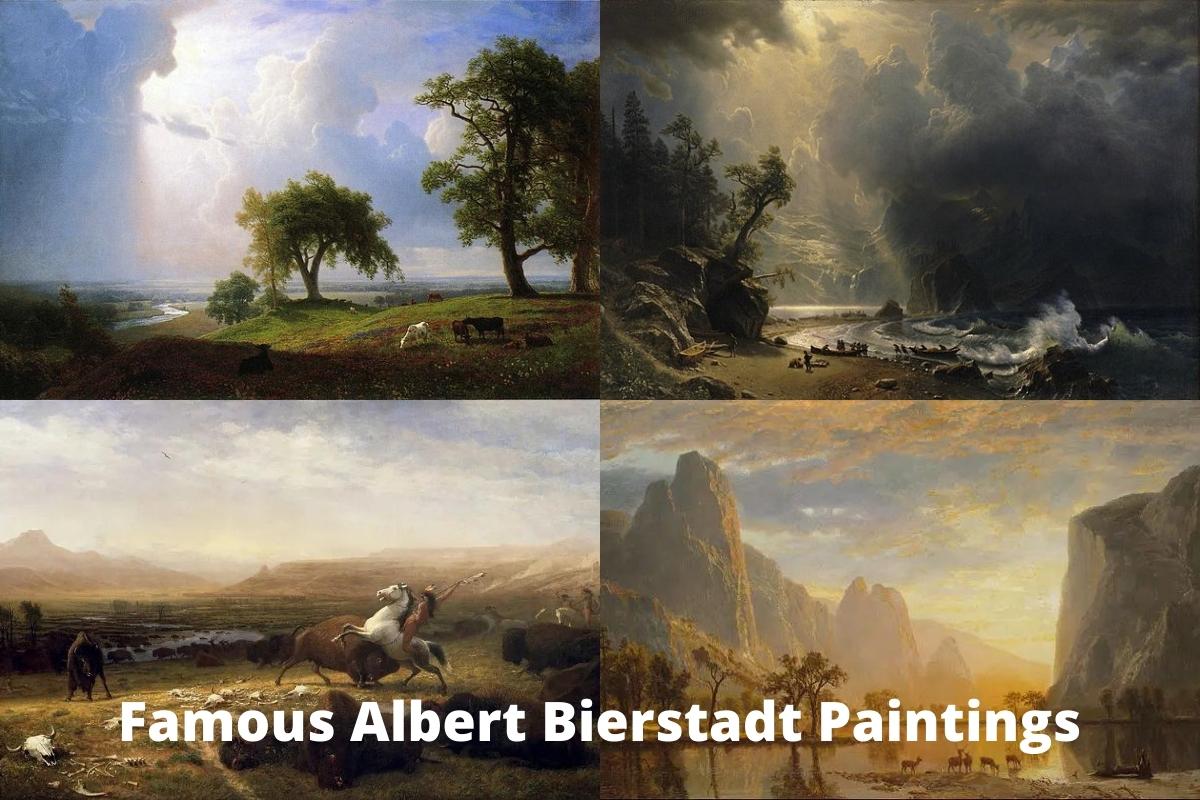Albert Bierstadt (January 7, 1830 – February 18, 1902) was a German-American painter best renowned for his opulent, expansive landscapes of the American West.
He painted images from various Westward Expansion expeditions. While he was not the first to record the locations, he was the most prolific painter of them for the rest of the nineteenth century.
Bierstadt was born in Prussia but came to the United States with his family when he was a year old. He returned to Düsseldorf to study painting for many years.
He became a member of the Hudson River School in New York’s second generation, an informal group of like-minded artists who began painting near the Hudson River.
Their style was characterized by meticulously detailed paintings illuminated by romantic, almost glowing illumination, a technique known as luminism. Bierstadt was a significant interpreter of the western environment and is also considered a member of the Rocky Mountain School.
Albert Bierstadt Famous Paintings
1. Valley of the Yosemite
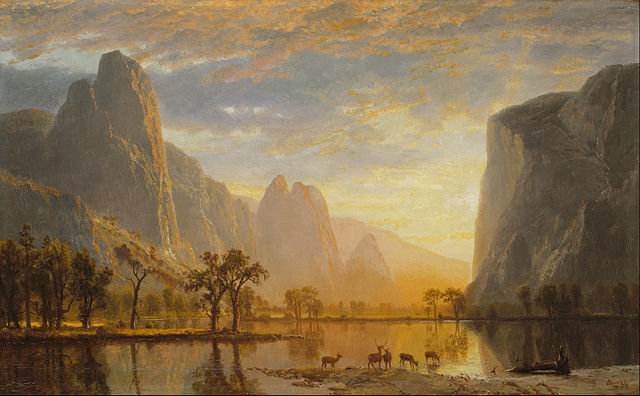
One of Bierstadt’s most famous paintings is a representation of Yosemite’s breathtaking valley, where the Merced River runs gently through a part surrounded by massive granite rock faces.
The picture, named Valley of the Yosemite, was completed in 1864, when settlers and others began to establish houses in the region.
Although the Yosemite region is regarded one of the most difficult and undeveloped wilderness areas on the North American continent, Bierstadt’s representation of the famed valley conveys a feeling of tranquillity and majesty to the observer.
The artist captured the movement of light over the river, as well as the mountains on each side, with deftness. The sun may be seen in the distance, casting its radiance on the high hills that flank both banks of the Merced River.
2. The Last of the Buffalo
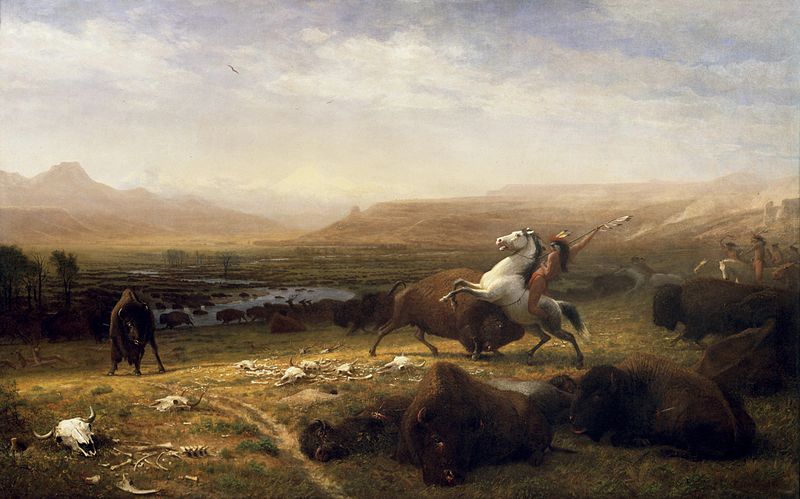
Throughout history, the buffalo has served as a symbol of Native American life and culture. Numerous Native American tribes in western North America depended largely on buffalo to survive the often severe winters on the western plains.
Bierstadt is known as one of the most important painters to have made works that were culturally and historically relevant to the situation of Native Americans who were being driven off their lands and forced to live on tiny reservations in harsh parts of the United States.
His artwork, The Last of the Buffalo, is possibly the most renowned Native American paintings ever made, since it includes enormous significance and symbolism, as well as a candid depiction of how westward development was wreaking devastation on Native people.
The picture, which is 6 by 10 feet in size, depicts a huge frontier filled with buffalo.
Many of these buffalo wander through the grasslands toward a tranquil river in this piece, however one of these beasts is engaged in fight with a tribal hunting party.
The buffalo charges a Native American hunter riding on a white horse, who is urgently attempting to stab the beast with a spear.
Bierstadt painted this piece in 1888, at a period when the buffalo were practically extinct. His art captures the last spectacular vestige of Native American culture that seemed to be fading along with the buffalo population.
3. The Rocky Mountains, Lander’s Peak
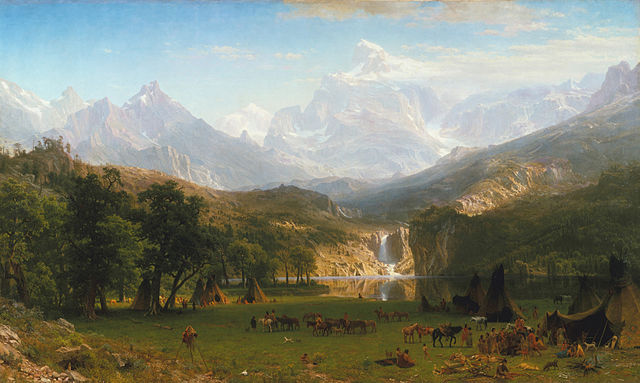
Albert Bierstadt’s 1863 landscape oil painting The Rocky Mountains, Lander’s Peak is a depiction of the Rocky Mountains. It is based on drawings produced during Bierstadt’s 1859 Honey Road Survey Party trips with Frederick W. Lander.
Lander’s Peak is shown in the Wind River Range of the Rocky Mountains, with a Native American campsite in the foreground. It has been likened to and shown alongside Frederic Edwin Church’s The Heart of the Andes. Lander’s Peak was an instant critical and popular triumph, selling for $25,000 in 1865.
Also Read: Famous Western Painters
The artwork depicts Lander’s Peak, a peak in modern-day Wyoming with a top elevation of 10,456 feet (3,187 m). On Bierstadt’s proposal, the summit was named after Frederick W. Lander after Lander’s death in the Civil War.
By depicting the majesty and unspoiled beauty of the nation’s western wilderness, Bierstadt’s painting struck a chord with current Americans. It was a nod to the concept of Manifest Destiny, in which the Rocky Mountains served as both a source of natural beauty and a barrier to westward progress.
4. Among the Sierra Nevada Mountains, California
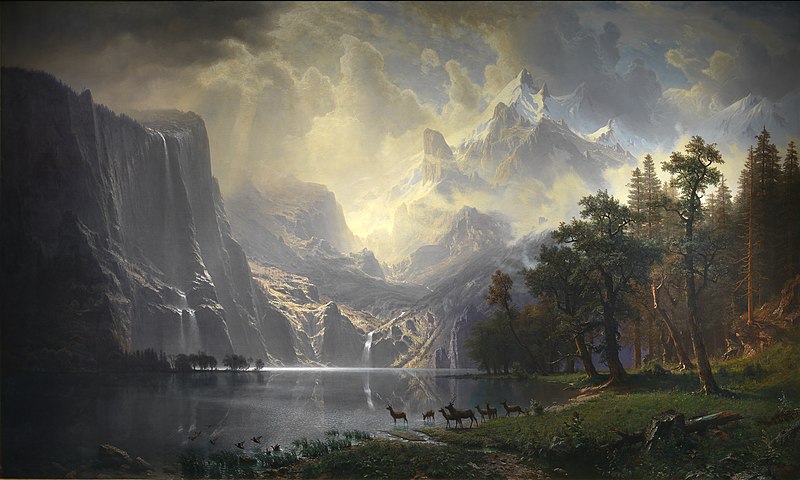
Among the Sierra Nevada, California (alternatively titled Among the Sierra Nevada Mountains) is an 1868 oil-on-canvas painting depicting a landscape scene in California’s Sierra Nevada mountain range. The artwork, which was created in his Rome studio, was displayed around Europe, sparking interest in immigration to the United States.
Among the Sierra Nevada was made in Rome during the winter of 1867–68, four years after Bierstadt’s Sierra Nevada visit.
On the left and in the background, the painting portrays craggy mountains reaching out to a brilliant sky with the Sun’s rays peeping through the clouds.
On the right side of the picture, the mountains overlook a tranquil lake with a group of deer and ducks on its edge, which is flanked by woods.
The picture, which measures 72 by 120+18 inches (183 by 305 cm), is the focus of the Smithsonian American Art Museum’s nineteenth-century landscape collection in Washington, D.C.
5. A Storm in the Rocky Mountains, Mt. Rosalie
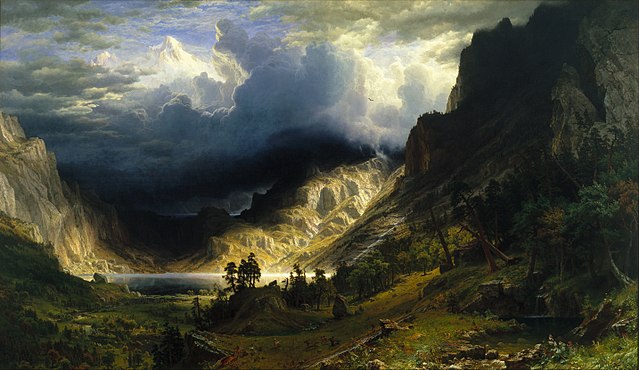
A Storm in the Rocky Mountains, Mt. Rosalie is a landscape oil painting by German-American painter Albert Bierstadt from 1866. It was inspired by drawings done during an 1863 trip.
Bierstadt proceeded to the Colorado Rocky Mountains, where he was transported to the Chicago Lakes, which are located under Mount Evans. The picture is titled Rosalie Osborne Ludlow after Bierstadt’s lover and, at the time, his friend’s wife.
The picture, which measures 210.8 by 361.3 centimeters (83.0 x 142.2 in), is on display at the Brooklyn Museum, which acquired it in 1976.
By the mid-nineteenth century, the United States government was dispatching surveying expeditions into the newly incorporated territories of the American West. Albert Bierstadt embarked on at least two of these voyages, which, together with earlier travels to the West, inspired a large portion of his artistic output.
Mt. Rosalie was conceived from drawings generated on his second tour to the West in 1863. Bierstadt’s journey would take him through the Colorado and Wyoming Rocky Mountains, then to Salt Lake City, Utah, and finally to California, where he would make stops at Lake Tahoe, San Francisco, and Yosemite.
By November 1863, the group had arrived at their final destination in Oregon. Ludlow and Bierstadt travelled back to New York on 17 December after an eight-month trek.
6. California Spring
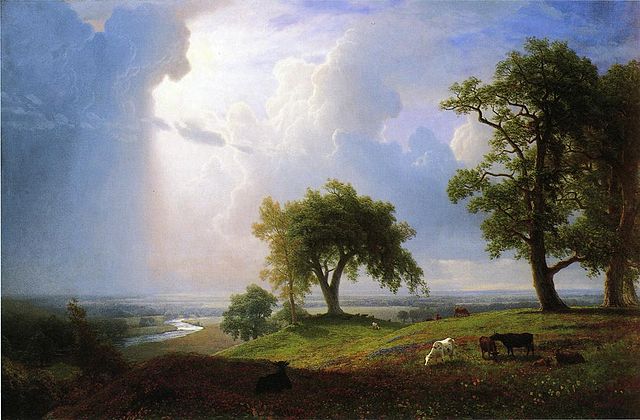
Bierstadt’s idyllic landscape along the banks of the Sacramento River in “California Spring” praises the American West as an Eden-like utopia, oblivious to the hard realities of agricultural life in the Central Valley, such as frequent droughts, overgrazing, and poverty.
On the full size painting if you look closely at the section of horizon between the California oak trees Bierstadt depicted the dome of the Sacramento State Capitol in minute detail in this section of the picture.
Constructed in 1874, only one year before Bierstadt completed “California Spring,” this iconic structure had an immediate impact on the surrounding environment.
7. Puget Sound on the Pacific Coast
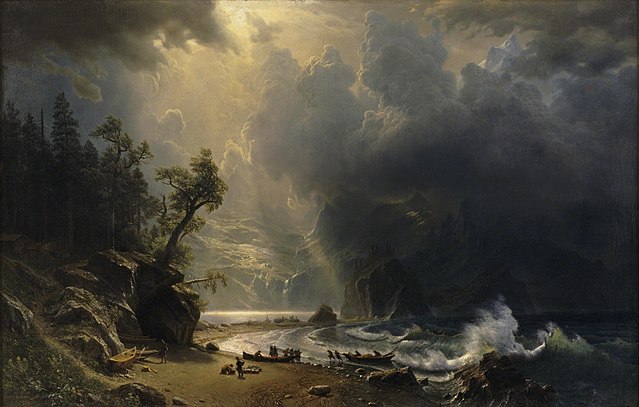
Puget Sound on the Pacific Coast is an 1870 oil landscape painting. Bierstadt had not yet visited what was then known as Washington Territory at the time the painting was completed. The piece, commissioned by Abiel Abbot Low, a China commerce entrepreneur, was created entirely from textual descriptions of the Sound.
Bierstadt created a stunning, large-scale painting of western coastal landscape; it was hailed as an authentic “picture” of Puget Sound by critics. However, Bierstadt had never seen Puget Sound; although the 1863 trip’s original endpoint was Puget Sound, he and Ludlow turned back before reaching there.
What he did paint, and the deft way in which he molded and controlled the very parameters of reality and fiction, landscape and history, are the topics of Patricia Junker’s short but richly illustrated monograph devoted to Bierstadt’s canvas.
8. Sunrise on the Matterhorn
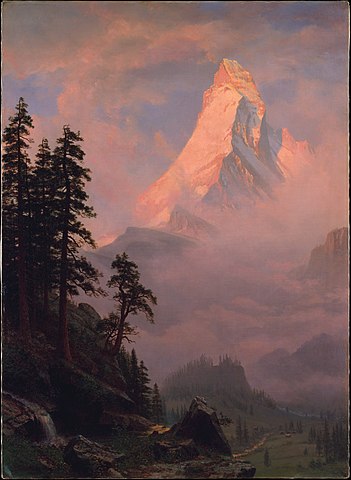
The artwork Sunrise on the Matterhorn is an oil on canvas depicting the renowned Matterhorn. It was created during one of Bierstadt’s several travels to Switzerland between 1867 and 1897. The Metropolitan Museum of Art now owns the picture.
The artist created this stunning picture of the Matterhorn by juxtaposing the cloud-encircled mountain in the distance with a low, rocky foreground. The mountain’s steep thrust is accentuated by the tall pines on the bottom left.
9. Looking Down Yosemite Valley, California
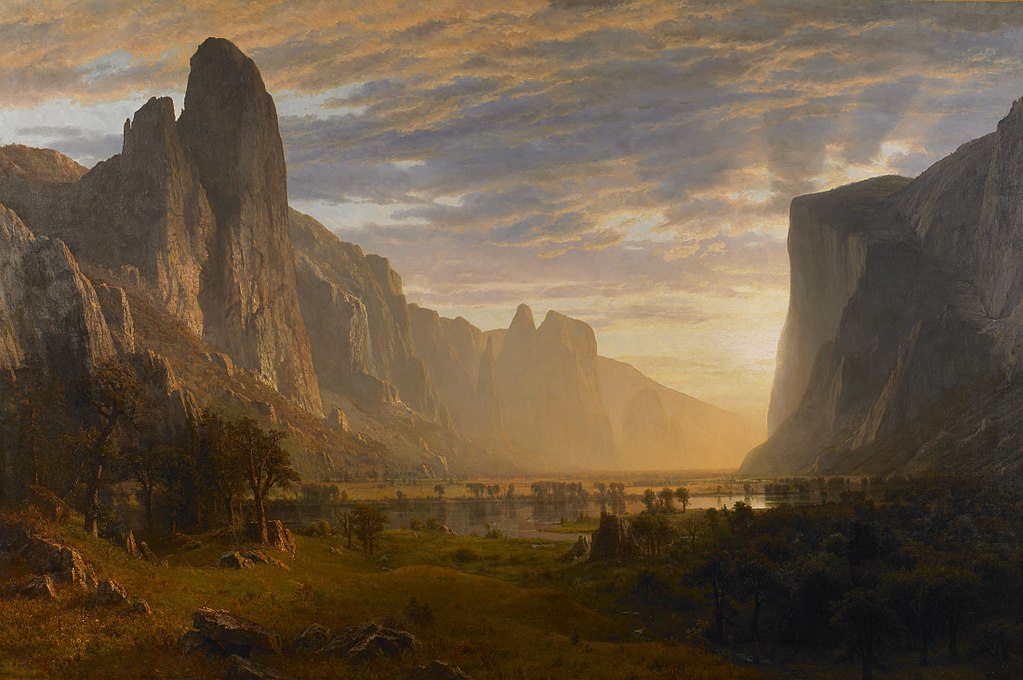
Many of Bierstadt’s greatest works are devoted to Yosemite Valley and the surrounding mountains, which were declared as a National Park in 1890.
Bierstadt’s 1865 painting focused on one of the most stunning vistas in the Yosemite region, the valley.
He was a renowned landscape artist who had already developed a sizable following among art fans in the United States as a result of his very realistic portrayals of situations like this.
Looking Down the Yosemite Valley is the title of the picture. According to art historians, Bierstadt visited the valley each day for many weeks or months in order to get the ideal show of light shimmering and reflecting off the cliffs of the mountains on each side of the valley.
10. Cho-looke, the Yosemite Fall
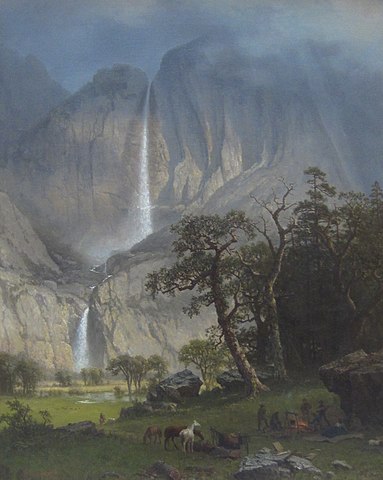
Bierstadt traveled to Yosemite Valley with a group of painters on his second western tour in 1863.
Yosemite Falls’ amazing magnitude and natural beauty are captured in this artwork.
Several guys assemble at their camp in the foreground, near an oak and cypress wood. A sketching umbrella, a color box, and other things that Bierstadt brought on the journey are shown in the painting’s right corner.
He was fascinated by the clean, “Edenic” valley’s sheer physical beauty. Bierstadt filled his sketchbooks with observations that he would later use to construct large-scale paintings back in New York City.
Cho-Looke, The Yosemite Fall was one of those landscapes, an exhibition painting that a writer lauded as “one of the artist’s greatest” during a studio visit in June 1864. President Abraham Lincoln signed a measure establishing Yosemite as a State Park the same month.

